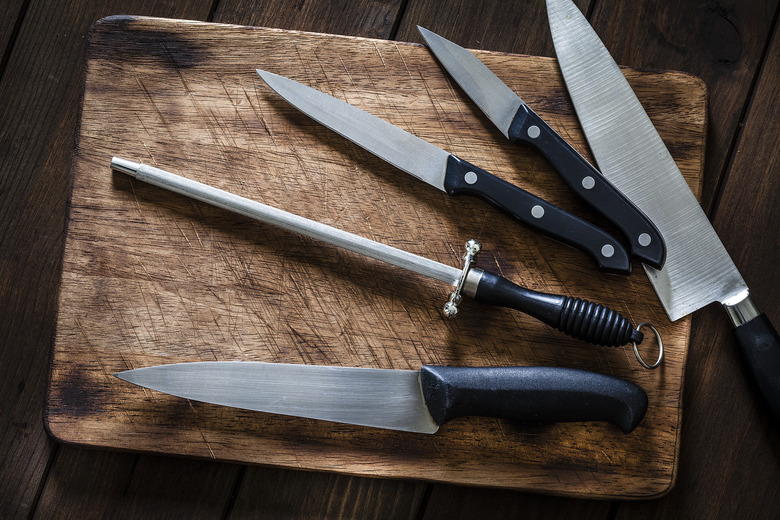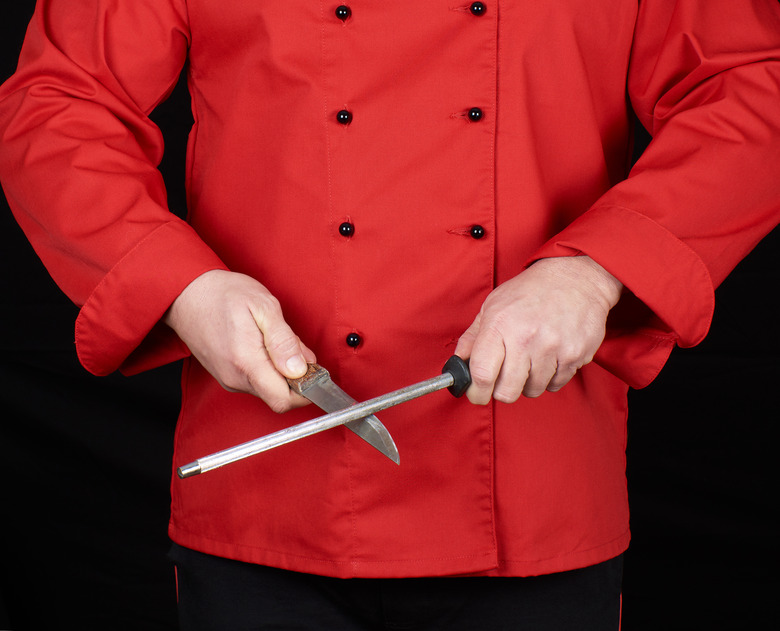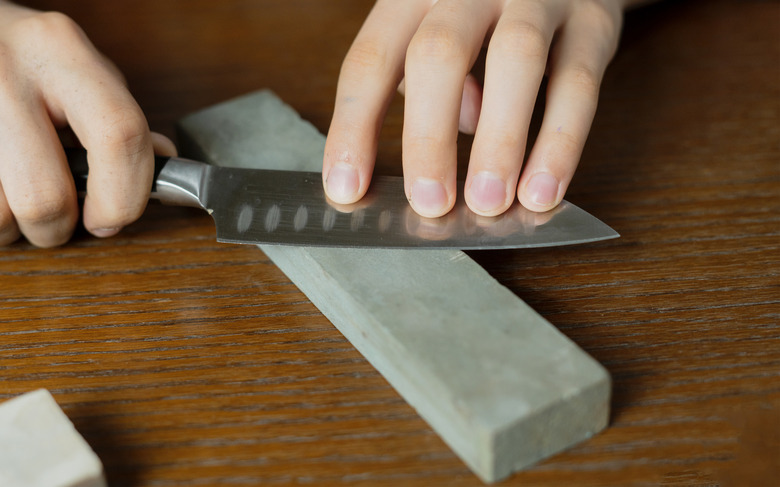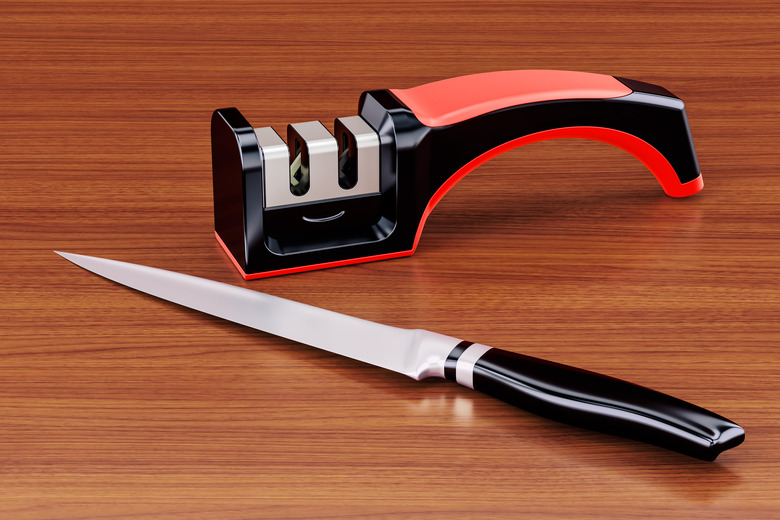How To Sharpen Kitchen Knives
A dull kitchen knife isn't only difficult to work with; it can be downright dangerous if the blade slips as you apply extra pressure to slice through foods. Sharpen knives as they start to get dull with either a knife sharpening steel, a whetstone or an electric knife sharpener.
Testing Knives for Sharpness
Testing Knives for Sharpness
If you suspect one of your favorite kitchen knives isn't as sharp as it used to be, test it out on a sheet of paper. Hold one sheet of regular copy paper vertically. Try to slice through it with the knife, starting from the top edge and slicing slowly at a slight angle towards the bottom. Ask a friend to hold the paper up if you find it awkward to hold the paper and slice with the knife at the same time.
If the knife cuts cleanly through the paper with little effort, it's still sharp. If it snags or tears the paper and doesn't cut the way you think it should, it needs to be sharpened.
Using a Sharpening Steel
Using a Sharpening Steel
A knife sharpening steel is a long rod that looks a bit like a round file, often included with sets of knives. This tool is best for keeping a knife sharp when it becomes slightly dull; it's not the right tool for the job when a knife is completely dull and practically useless. A sharpening steel helps "reset" the blade so its cutting edge is fairly even across the length of the blade.
Step 1
Hold the sharpening steel vertically, with the handle end up. Push the other end down onto a countertop to stabilize the tool.
Step 2
Hold the knife in your other hand near the top of the sharpening steel. Tilt the knife so the blade points inward, toward, the sharpening steel, at about a 15-degree angle.
Step 3
Slide the knife blade along the sharpening steel, starting with the back of the blade, pulling the knife toward you. The tip should be facing outward.
Step 4
Repeat the process with the knife on the other side of the sharpening steel, again tilting the blade at about a 15-degree angle toward the sharpening steel. Slide the blade along the steel, from tail end to tip. Continue with several more passes on each side of the knife blade.
Sharpening with a Whetstone
A whetstone offers a means to sharpen knives that are significantly dull, although it takes a little practice to sharpen the knives evenly. Look for a whetstone that has one coarse and one finer side; this way you can perform a general sharpening on any kitchen knife, then smooth it out on the fine side. Choose a whetstone designed to soak in water, such as a diamond grit stone, as these are easier to care for than whetstones used with oils.
Things Needed
-
Water
-
Whetstone
-
Folded towel or anti-slip pad
Step 1
Soak the whetstone in water for 5 minutes, or until bubbles no longer come out of the stone. Remove the whetstone from the water and shake off the excess water.
Step 2
Set the stone coarse-side-up atop a folded dish towel or a piece of non-slip padding large enough to hold the stone in place on the table.
Step 3
Note the angle of the cutting edges on the knife blade. Hold the knife at that angle, relative to the stone, so that when pressed down, only the cutting edge on one side of the blade will touch the stone. Keeping this angle helps rework the original cutting edge so the knife becomes sharp again. Draw the knife toward you along the surface of the stone, then push it away from you at the same angle. Repeat this process several times.
Step 4
Flip the knife over and again hold it at the exact angle of the cutting edge, so only the cutting edge will make contact with the whetstone. Draw the knife toward you along the stone, then push it away along the stone. Repeat several times.
Step 5
Test the cutting edge of the knife by slicing a piece of paper with it. If it slices with virtually no effort, the knife is sharp.
Step 6
Flip the whetstone over so the fine grit is face up, then repeat the sharpening process on one side of the blade, then the other, again keeping the proper angle. Repeat several times. This helps smooth the edge on the blade, making it ultra sharp.
Tip
It takes a bit of time to sharpen an extremely dull blade. The amount of time it takes depends on how dull the blade is and how well you've maintained the proper angle while honing the blade along the stone.
Sharpening With Manual and Electric Sharpeners
As with pencil sharpeners, both manual and electric knife sharpeners turn a dull blade sharp again in virtually no time. With either type, choose a model with several coarseness settings, each offering its own pair of slots for cleaning up a dull knife blade. Always read the sharpener manual before use, as some models have extra or different features than others.
Things Needed
-
Manual or electric knife sharpener
-
Damp clean rag or dishcloth
-
Kitchen towel
Step 1
Plug in the sharpener and turn it on. If using a manual version, there's no need to plug it in or turn it on.
Step 2
Insert a knife blade into the left coarse slot on the sharpener so that the back end of the blade, closest to the handle, is inserted into the slot as far as it can go.
Step 3
Draw the knife toward you through the left sharpener slot without letting it wobble. Repeat the process on the right slot of the coarse sharpener. Run the knife both slots, one after the other, for 10 to 20 pulls through each slot, or as recommended by the manufacturer.
Step 4
Repeat the process with the knife in medium coarseness set of slots, then follow up with the touchup slots. Wipe the knife blade off with a damp clean rag or dishcloth, then dry it with a dish towel.
Tip
If the knife is moderately sharp before you use the electric sharpener, there's no need to run it through the coarsest sharpening slots. Start with a medium or fine sharpening option instead.
About Serrated Knives
About Serrated Knives
Serrated knives, such as a common steak knife, are not meant to be sharpened on whetstones or in electric sharpeners. Instead, use a serrated knife sharpener that looks like a round or "rat tail" file. These are smaller than sharpening steels, and are used by drawing the sharpener along the grooves or serrations on the knife, much like using a file.



